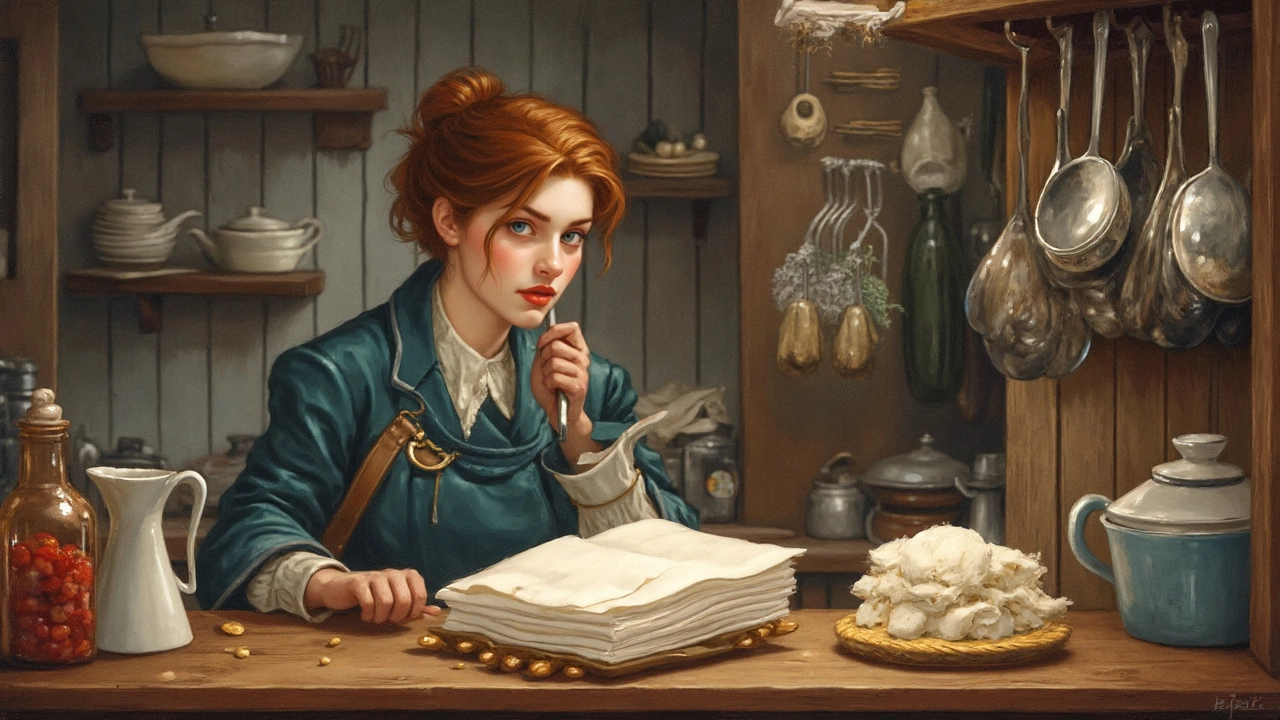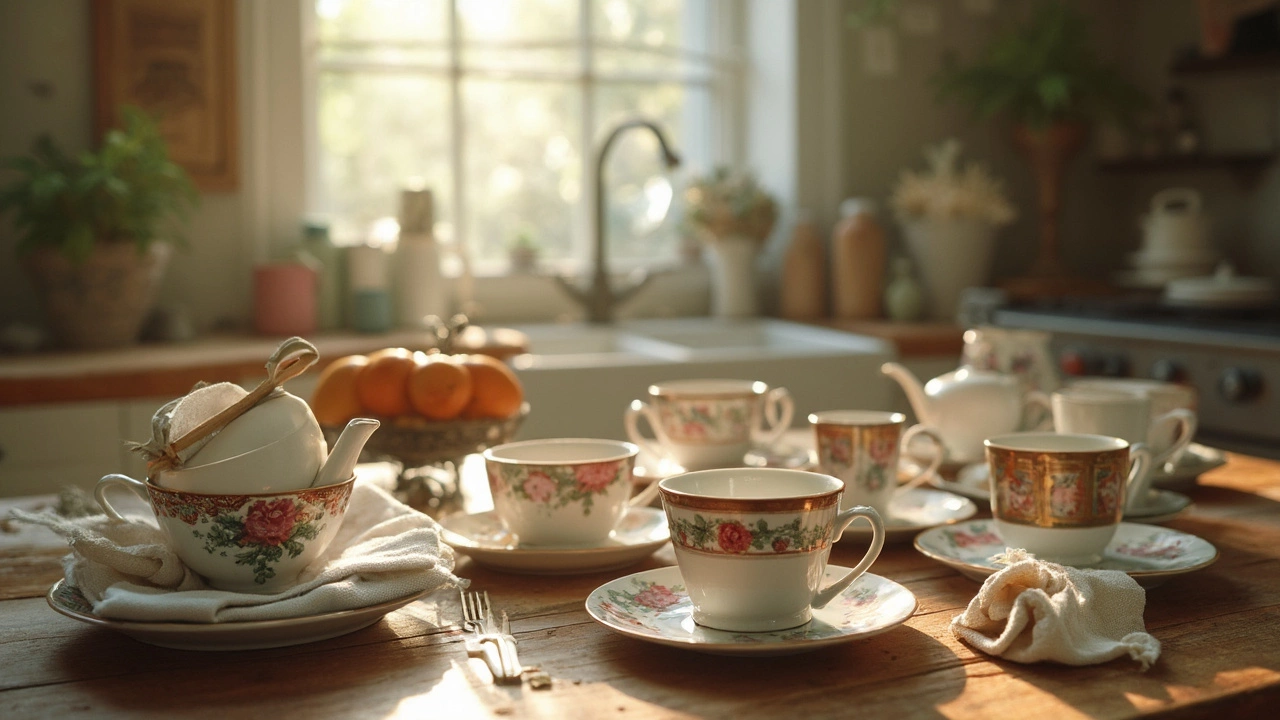Cups and napkins, huh? They’re staples in every home, yet we rarely stop to think about them. Why bother, you ask? Well, imagine a dinner party without glasses or a barbecue without something to clean up that sauce spill. These humble items have centuries of history and more variety than you might guess.
Starting with cups, they’ve been around forever—since ancient times, actually. A lot has changed since folks sipped from carved stones or clay. Today, they're not just clay or glass; you've got metal, plastic, and so many design choices that it's almost overwhelming. Whether you're enjoying a hot cup of joe or a chilled soda, there's a cup for every occasion.
- History of Cups
- Types of Cups
- Materials Used for Cups
- Napkins and Their Origins
- Choosing the Right Napkins
- Everyday Uses and Care
History of Cups
The history of cups is more fascinating than you might think! People have been drinking from some sort of vessel for thousands of years. The earliest records show that humans started off with what they could find, like shells and hollowed-out stones. Over time, these primitive cups evolved as folks figured out better ways to hold their drinks.
Cups made from clay and ceramics appeared around 4,000 BC. They changed everything, making it possible to create more sophisticated styles. Imagine having a design that keeps your hands from getting burned—everyone loves a proper handle! This innovation came from ancient Greece and became pretty popular across Europe.
Metal Cups and Their Rise
Fast forward to the Middle Ages, and you’ll find the rise of metal cups. Crafted from silver, bronze, or gold, these were not only functional but status symbols. If you had a metal cup, you were considered quite fancy!
But the most iconic shift came with the introduction of glass cups. They emerged during the Roman Empire but became particularly trendy in the Middle Ages. Glass brought a new touch of elegance, and by the Renaissance, glassmakers were true artists.
In modern times, the diversity of materials used for cups keeps expanding. Here's a glimpse of the evolution:
- Clay - Basic and functional.
- Metal - For the elite, durable.
- Glass - Elegant and timeless.
- Plastic - Lightweight and affordable.
Every material has its own story and place in our history. Cups started with a simple need—to drink—but have become an everyday essential in every kitchen around the world.
Types of Cups
Cups are everywhere, and with good reason—they're essential. But not all cups are created equal. Let’s break it down so you know which cup is best for what. From the coffee aficionados to tea lovers, there's a specific cup for every drink. It's all about matching the right one to your needs.
Coffee Cups
Coffee cups are designed to keep your brew warm just long enough to savor each sip. Standard coffee mugs are usually made of ceramic because it’s great at retaining heat. Some prefer a thicker rim, while coffee purists swear by thinner ones for 'flavor purposes.' Who knew, right?
Tea Cups
Tea cups might seem similar to coffee mugs, but there's a twist. They're generally smaller, allowing tea to cool to just the right temperature. Plus, many insist the thinner the wall, the better the taste. Porcelain or bone china usually reigns supreme here, giving it a touch of class.
Travel Mugs
If you’re always on the move, a travel mug is your best friend. Typically made of stainless steel or high-grade plastic, they’re built to withstand those bumps in the car or crowded subway rides. Bonus points for keeping your drink hot or cold for hours. Handy, right?
Glass Cups
Ever noticed how fancy restaurants often use glass cups? They’re not just for show. Glass doesn’t impart any flavors, making it perfect for juices, sodas, or cocktails. Just be careful—they’re fragile and not as forgiving on those clumsy mornings.
Measuring Cups
Okay, these are not for drinking, but they’re important kitchenware. You can't bake a cake or mix up a recipe without them. Usually made of plastic or metal, they've got precise markings so you get the right amount every time.
| Type of Cup | Material | Main Use |
|---|---|---|
| Coffee Mug | Ceramic | Hot beverages |
| Tea Cup | Porcelain | Tea |
| Travel Mug | Stainless Steel | On-the-go drinks |
| Glass Cup | Glass | Cold beverages |
| Measuring Cup | Plastic/Metal | Cooking |
Choosing the right cup can make all the difference. So next time you grab one from the cupboard, you'll know exactly what works best for your drink of choice. Cheers to making those kitchenware choices count!
Materials Used for Cups
Ever wondered why some cups keep your drinks hot or cold for longer? It's all about the materials they're made from. Let's have a look at some popular options and their pros and cons.
Ceramic and Porcelain
Ceramic and porcelain are classic choices. They're perfect for a cozy cup of coffee or tea, thanks to their ability to maintain temperature pretty well. Plus, they're easy on the eyes with endless design possibilities. The downside? They can chip or break if you're not careful.
Glass
Glass cups look slick and are great for cold drinks. They're non-reactive, so no worries about any chemical leaching into your drink. Just keep in mind, they aren't the best for insulating heat, meaning your hot drink might cool down quicker than you'd like.
Stainless Steel
Stainless steel cups are a solid pick for outdoor activities. They're virtually unbreakable and offer terrific insulation. Many are double-walled, so they can keep your drink at just the right temp, hot or cold, for hours. They're not everyone's cup of tea though, as some folks think it gives a metallic taste.
Plastic
Plastic cups are budget-friendly and super versatile. They're light and won't shatter if dropped, making them perfect for picnics or poolside lounging. But not all plastics are the same; look for BPA-free options to avoid nasty chemicals.
Enamel
Enamel cups give off a retro vibe and are quite durable. They're usually made from metal and coated with enamel, which is tough and heat resistant. They're a pretty solid choice for camping. Just watch out for chips in the coating over time.
Whether it's sturdy stainless steel for that camping trip, or a sleek glass cup for dinner parties, choosing the right material really digs into how you plan to use your kitchenware.

Napkins and Their Origins
Ever stop to wonder how we ended up with napkins at our dinner tables? They aren't just about looks; they go way back in time. Picture this: ancient Greeks using pieces of bread to clean their fingers at meals—kind of like those super-efficient paper towels, but tastier. Jump to the Middle Ages, and cloth napkins became more of a thing, popping up at royal feasts where table manners got fancy.
Fast forward to the 16th century and napkins got serious. Some French were already obsessed with napkin folding as an art form (yes, origami at the table!). This wasn't just about hygiene anymore, but a show of sophistication. Napkins evolved with these changes in dining culture, from being purely functional to making a statement.
Materials of Napkins
These days, napkins come in all shapes and sizes. The two big categories? Paper and cloth. Paper napkins are all about convenience—birthday parties, BBQs, you name it. They're cheap and easy, but maybe not the best for the environment. Cloth napkins, on the other hand, bring a touch of elegance and are reusable, making them eco-friendly. Cotton and linen are the popular choices, though each has its own perks. Cotton? Soft and absorbent. Linen? Durable and looks upscale.
| Type | Advantages | Disadvantages |
|---|---|---|
| Paper | Convenient, Disposable | Not eco-friendly, Single-use |
| Cloth | Reusable, Stylish | Requires washing, Higher upfront cost |
Napkin Tips
Want to pick the right napkin for your table? Consider the occasion. Casual meetup? Go paper. Fancy dinner? Cloth is your friend. Also, think about color and pattern—match them with your dishware for vibes or contrast them for a pop of style. And don't forget to remind folks of a critical use: napkins aren't just arm candy; they're there to keep you and your clothes clean!
Choosing the Right Napkins
When it comes to napkins, variety is the spice of life. From cloth to paper, every option has its place. But how do you choose the right one for your occasion?
Cloth vs. Paper: The Big Debate
Cloth napkins scream elegance. They're perfect for formal dinners or when you want to impress. Plus, they're reusable, which is great for the environment. On the flip side, washing them can be a hassle, and they’re not super cheap upfront.
Paper napkins, on the other hand, are convenient for everyday use or picnics. They’re disposable, so no laundry, but if you're eco-conscious, this might give you pause.
When to Use What?
If you’re hosting a fancy dinner, cloth is your go-to. Weddings, anniversaries, sometimes even a special family meal—go for elegance.
For casual meetups or BBQs, paper is your best bet. They’re inexpensive, easy to match with themes (think holiday napkins), and you won't mind if kids get a bit messy with them.
Factor in Budget and Style
Your choice might also depend on budget and personal style. Cloth napkins have an initial investment but last longer. Paper napkins save time and keep costs low. It's all about what works for you.
Eco-Friendly Options
In recent years, there’s been a rise in eco-friendly napkins made from recycled materials. If sustainability is a priority, look for brands specializing in bamboo or recycled paper napkins.
Here's a quick comparison:
| Type | Cost | Durability | Environment |
|---|---|---|---|
| Cloth | High | Long-lasting | Eco-friendly |
| Paper | Low | Single-use | Not very eco-friendly |
| Eco-friendly Paper | Moderate | Single-use | Better than regular paper |
No matter what you choose, napkins are a necessity that also reflect your style and priorities. Weigh the pros and cons, and you’ll have an impeccable table setup for any occasion!
Everyday Uses and Care
When it comes to napkins and cups, everyday use seems pretty straightforward, but there are some tips and tricks to make your life easier. Napkins are more than just paper squares; they come in cloth varieties that are not only eco-friendly but also add a touch of elegance to your dining setup. Imagine hosting a dinner party with cloth napkins folded into creative shapes—instant class.
On the flip side, disposable napkins are super convenient, especially for picnics or kids' parties. But let's not forget the classic spill cleanup. Just remember, whichever type you use, choosing a good absorbent material is key.
Care for Your Kitchenware
- Cups: Dishwasher safe ones are super handy. For glass or ceramic cups, placing them on the top rack is usually your best bet to avoid chipping.
- Napkins: Cloth versions can be tossed in with regular laundry. Just keep colors separate—no one wants pink napkins unless they started that way.
Driving down to the balance between practicality and looks, the right choices in your kitchen can make a big difference. And if you’re into tableware that matches, there are entire collections that offer kitchenware sets so your cups and napkins coordinate effortlessly.
Want a pro tip? When setting up your dining table, have a mix of napkins ready—paper for messier foods and cloth for the main course. It’s about convenience and style, all while keeping things functional.

